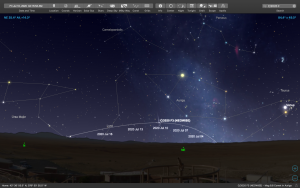How to Find, Observe and Photograph Comet C/2020 F3 (NEOWISE)
For the next few days, early (before sunrise) is the only option. you will need a good view to the NE horizon. The comet is about one fist held out at arms length below the bright star Capella (located in the constellation Auriga). Dark Skies help (especially to see the comet without optical aid), but the good view of the horizon is a must. Try to be out to your observing location by 4 AM. So far this week the “sweet spot” has been between 4:15 am and 4:45 am. The comet is visible to the naked eye, but it is best to find it in binoculars first, then try to locate it without optical aid. A small telescope, like a spotting scope or birding scope will work well too.

Around July 12 – 15, the comet will appear early in the evening sky very close to the NW horizon, well below the bowl of the Big Dipper. The comet will continue to rise after that and start to approach the Big Dipper.

How to photograph the Comet:
Want to try to capture a picture of the comet? Have a DSLR and a tripod? Observatory Director Dan Marcus offers some advice for finding and photographing the comet. According to Dan, the same advice hold true for when you look for it in the morning or evening sky. You will need a LOW horizon to see it and a compass to help you get the right bearing. Use a 50 mm lens and put it where you think the comet should be located. If you are in morning or evening twilight (sky not fully dark), start by using you the camera’s automatic setting mode and reduce the exposure until the camera says it is too dark. You’ll want to under expose the image so the sky is a dark blue and not washed out. If the sky is dark you will need to use the camera’s manual settings. Regardless if you use the camera’s automatic or manual settings, don’t overexpose the image as overexposing the image will cause the sky and the comet to appear washed out.
Also, most smartphones have really impressive low light capability. You can snap an image through the eyepiece of binoculars or a telescope. Also, you may be able to capture the comet in a wide-field shot. Having the phone on a tripod or leaning on something stable will help with getting a sharper image. Learn how to manipulate exposure, focus, and zoom controls on your phone to get the best results.
Good Luck and Clear Skies!
